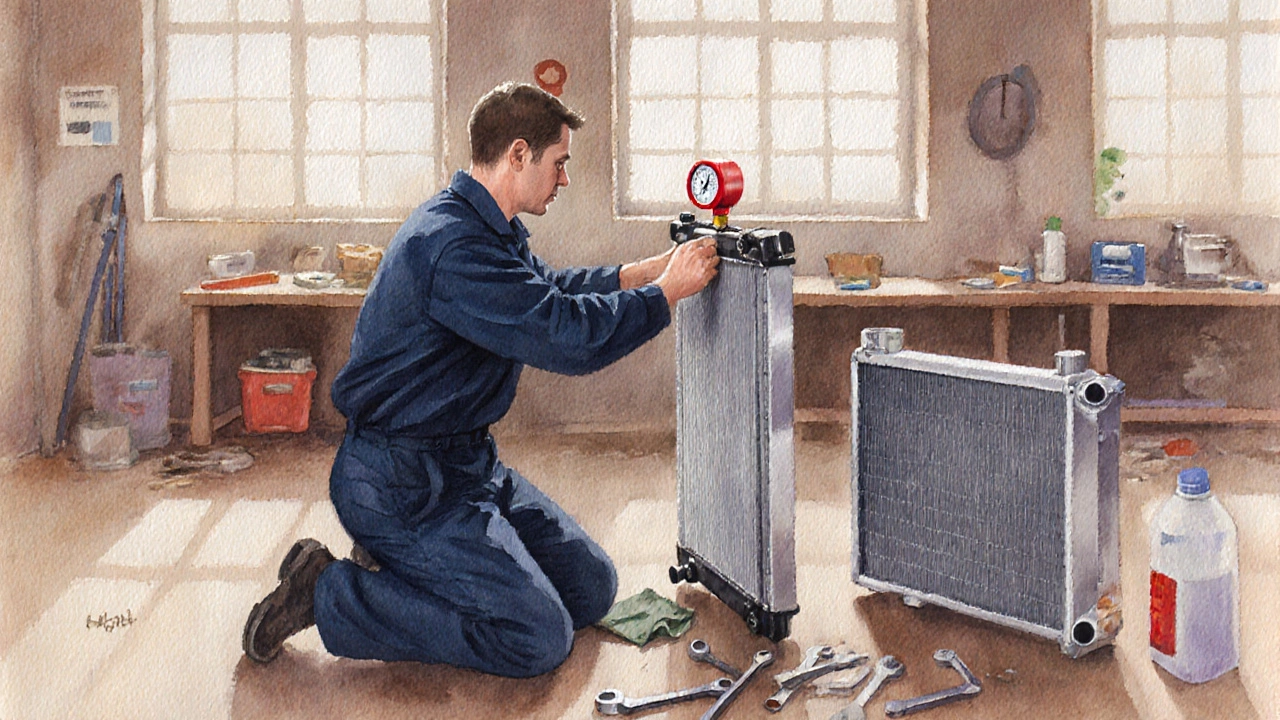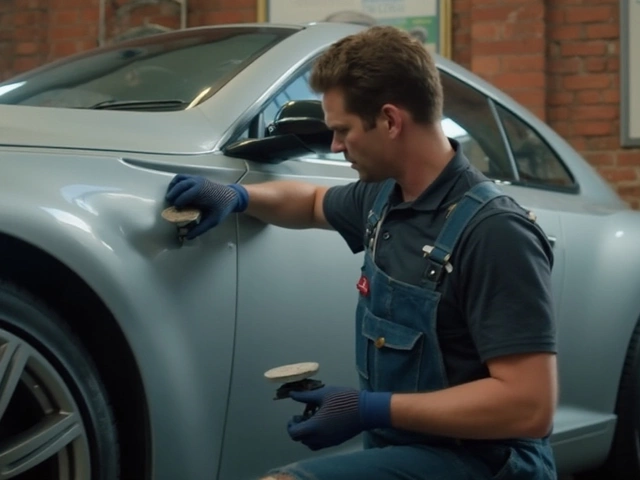Radiator Problem Checker
Select symptoms and click "Check Symptoms" to analyze your radiator condition.
Key Takeaways
- A car can keep moving for a short time with a bad radiator, but overheating will quickly cause serious engine damage.
- Typical signs include steam, coolant loss, temperature gauge spikes, and a sweet smell.
- Immediate actions: pull over, turn off the engine, check coolant level, and add water only as a temporary measure.
- Permanent repair usually means flushing the system or replacing the radiator, thermostat, or water pump.
- Regular coolant checks and annual radiator flushes prevent most failures.
What Is a Car Radiator?
When the engine runs, it generates a lot of heat. The car radiator is a heat‑exchanger that moves heat from the engine coolant to the outside air, keeping the engine at a safe operating temperature. It typically consists of a thin metal core, a plastic tank, and a series of fins that increase surface area for better cooling. The radiator works alongside the engine coolant, the thermostat, the water pump, and the radiator fan to form the complete cooling system.
Can a Car Actually Run with a Bad Radiator?
The short answer is yes-if the problem is minor. A cracked plastic tank, a small leak, or a clogged fin may let the engine run for a few minutes, but heat will build up fast. As the coolant temperature climbs past the thermostat’s opening point, the engine will overheat. Modern cars have temperature gauges and warning lights that will flash well before catastrophic failure.
If you ignore the warning, you risk warped cylinder heads, blown head gaskets, or a seized engine. Those repairs run into the thousands, so the safest route is to treat any radiator issue as an emergency.

Symptoms That Your Radiator Is Going Bad
Spotting the problem early can save you a lot of hassle. Look out for these tell‑tale signs:
- Steam or white vapor rising from the front of the car.
- Coolant level dropping quickly in the coolant reservoir. \n
- Engine temperature gauge climbing into the red zone.
- Sweet, syrupy smell inside the cabin-coolant is leaking onto hot parts.
- Visible puddles of green, orange, or pink fluid under the vehicle.
- Unusual rattling or buzzing from the radiator fan.
- Overheating after a short drive, even when the outside temperature is mild.
What to Do the Moment You Suspect a Bad Radiator
Stay calm and follow these steps to avoid major damage:
- Pull over safely and turn the engine off. Give it a few minutes to cool.
- Open the hood and locate the coolant reservoir. If the fluid is low, add a 50/50 mix of distilled water and coolant, or just water if you’re in a pinch.
- Check for obvious leaks-look under the radiator, hoses, and around the water pump.
- If you see a leak, try to seal a small crack with a commercial radiator sealant as a temporary fix.
- Restart the engine and watch the temperature gauge. If it spikes again, shut it down immediately.
- Call roadside assistance or a local garage. Driving further can destroy the engine.
Temporary Fixes vs. Permanent Repair
| Fix Type | Typical Cost | Time Needed | Effectiveness | Longevity |
|---|---|---|---|---|
| Add water only | £0-£5 | 5minutes | Provides short‑term cooling | Minutes to a few miles |
| Radiator sealant (spray) | £10-£20 | 10minutes | Can seal small leaks | Few hours to a day |
| Flush and refill coolant | £30-£70 | 1hour | Removes debris, restores flow | 6-12months |
| Replace radiator | £150-£400 (plus labour) | 2-3hours | Restores full cooling capacity | 8-12years |
| Replace thermostat or water pump | £80-£250 | 2hours | Fixes flow or temperature regulation | 5-10years |
Temporary fixes are just that-temporary. If you notice repeated overheating, schedule a proper repair within 24hours.

Diagnosing the Exact Problem
Mechanics use a few reliable methods to pinpoint the issue:
- Pressure test: A special gauge pressurizes the cooling system. If the pressure drops, there’s a leak.
- Temperature probe: Attaches to the radiator inlet and outlet to see if heat exchange is happening.
- Visual inspection: Look for corrosion, rust, or blocked fins. A garden hose can clear surface debris.
- Thermostat snap‑test: Remove the thermostat and place it in hot water; it should open at its rated temperature (usually 88°C).
Many DIYers can perform the visual check and a basic pressure test with a cheap kit from an auto parts store.
When to Replace the Radiator Entirely
Consider a full replacement if you encounter any of the following:
- Multiple leaks or a large crack in the core.
- Severe corrosion that has eaten through the metal.
- Persistent overheating even after a coolant flush.
- Cold spots inside the radiator, indicating internal blockage.
- Age over 10years for most aluminum units, or 5years for plastic tanks.
Choosing a quality replacement-OEM or reputable aftermarket-ensures proper fit and longevity.
Preventive Maintenance Tips
Keeping the cooling system healthy is easier than fixing a busted radiator.
- Check coolant level and condition every month. Fresh coolant is clear, not cloudy.
- Replace coolant according to the manufacturer’s schedule, typically every 2-4years.
- Inspect hoses for cracks, bulges, or soft spots before long trips.
- Clean the radiator fins with a soft brush and low‑pressure air to remove debris.
- Verify the radiator fan engages when the engine reaches operating temperature.
- Use a pressure cap rated for your vehicle; a weak cap can cause boiling and loss of coolant.
Following these steps can extend the radiator’s life well beyond its average lifespan.
Frequently Asked Questions
Can I drive my car with a leaking radiator for a short distance?
Only if the leak is very small and you can keep an eye on the temperature gauge. Add water to maintain coolant level, stay under 50mph, and pull over the moment the gauge climbs into the red. It’s a risky stop‑gap, not a long‑term solution.
What does a sweet smell coming from the engine bay mean?
The smell usually indicates coolant (ethylene glycol) is leaking onto a hot surface, such as the exhaust manifold. It’s a clear sign of a radiator leak, hose rupture, or a cracked water pump.
Is a radiator fan failure as serious as a radiator leak?
Both can cause overheating, but a fan failure is electrical and often shows up as the fan not spinning at idle or high temperature. A leak removes coolant, which defeats the whole system. Either issue needs prompt repair.
How often should I flush my car’s cooling system?
Most manufacturers recommend a flush every 30,000km (about 20,000miles) or every 2-4years, whichever comes first. If you notice rust or a gritty coolant, flush sooner.
Can I use plain water instead of coolant in an emergency?
Water can prevent immediate overheating, but it lacks corrosion inhibitors and boiling point protection. Use it only to get you to a safe location, then replace with the proper 50/50 coolant mix as soon as possible.






